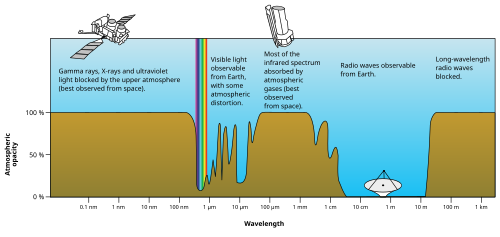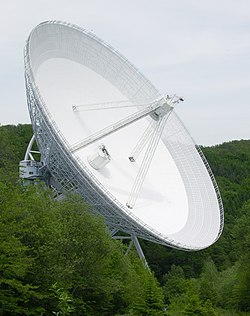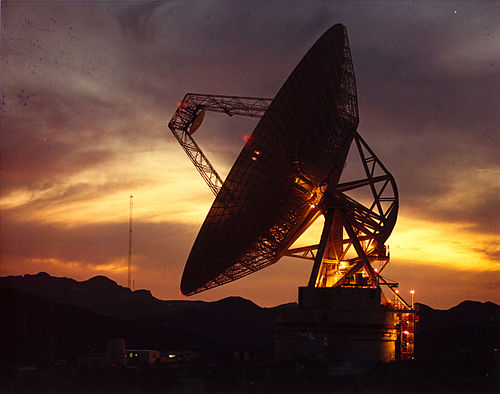Radio telescope

A radio telescope is a specialized
Since astronomical radio sources such as planets, stars, nebulas and galaxies are very far away, the radio waves coming from them are extremely weak, so radio telescopes require very large antennas to collect enough radio energy to study them, and extremely sensitive receiving equipment. Radio telescopes are typically large parabolic ("dish") antennas similar to those employed in tracking and communicating with satellites and space probes. They may be used individually or linked together electronically in an array. Radio observatories are preferentially located far from major centers of population to avoid electromagnetic interference (EMI) from radio, television, radar, motor vehicles, and other man-made electronic devices.
Radio waves from space were first detected by engineer
Early radio telescopes
The first radio antenna used to identify an astronomical radio source was built by
An amateur radio operator,
Types

The range of frequencies in the electromagnetic spectrum that makes up the radio spectrum is very large. As a consequence, the types of antennas that are used as radio telescopes vary widely in design, size, and configuration. At wavelengths of 30 meters to 3 meters (10–100 MHz), they are generally either directional antenna arrays similar to "TV antennas" or large stationary reflectors with movable focal points. Since the wavelengths being observed with these types of antennas are so long, the "reflector" surfaces can be constructed from coarse wire mesh such as chicken wire.[5] [6] At shorter wavelengths parabolic "dish" antennas predominate. The angular resolution of a dish antenna is determined by the ratio of the diameter of the dish to the wavelength of the radio waves being observed. This dictates the dish size a radio telescope needs for a useful resolution. Radio telescopes that operate at wavelengths of 3 meters to 30 cm (100 MHz to 1 GHz) are usually well over 100 meters in diameter. Telescopes working at wavelengths shorter than 30 cm (above 1 GHz) range in size from 3 to 90 meters in diameter.[citation needed]
Frequencies
The increasing use of radio frequencies for communication makes astronomical observations more and more difficult (see Open spectrum). Negotiations to defend the frequency allocation for parts of the spectrum most useful for observing the universe are coordinated in the Scientific Committee on Frequency Allocations for Radio Astronomy and Space Science.

Some of the more notable frequency bands used by radio telescopes include:
- Every frequency in the United States National Radio Quiet Zone
- Channel 37: 608 to 614 MHz
- The "The Big Ear in its discovery of the Wow! signal
- 1,406 MHz and 430 MHz [7]
- The Waterhole: 1,420 to 1,666 MHz
- The Arecibo Observatory had several receivers that together covered the whole 1–10 GHz range.
- The cosmic microwave background radiationin 5 different frequency bands, centered on 23 GHz, 33 GHz, 41 GHz, 61 GHz, and 94 GHz.
Big dishes

The world's largest filled-aperture (i.e. full dish) radio telescope is the
The world's second largest filled-aperture telescope was the
The largest individual radio telescope of any kind is the
The above stationary dishes are not fully "steerable"; they can only be aimed at points in an area of the sky near the zenith, and cannot receive from sources near the horizon. The largest fully steerable dish radio telescope is the 100 meter Green Bank Telescope in West Virginia, United States, constructed in 2000. The largest fully steerable radio telescope in Europe is the Effelsberg 100-m Radio Telescope near Bonn, Germany, operated by the Max Planck Institute for Radio Astronomy, which also was the world's largest fully steerable telescope for 30 years until the Green Bank antenna was constructed.[11] The third-largest fully steerable radio telescope is the 76-meter Lovell Telescope at Jodrell Bank Observatory in Cheshire, England, completed in 1957. The fourth-largest fully steerable radio telescopes are six 70-meter dishes: three Russian RT-70, and three in the NASA Deep Space Network. The planned Qitai Radio Telescope, at a diameter of 110 m (360 ft), is expected to become the world's largest fully steerable single-dish radio telescope when completed in 2028.
A more typical radio telescope has a single antenna of about 25 meters diameter. Dozens of radio telescopes of about this size are operated in radio observatories all over the world.
Gallery of big dishes
-
The 500 meter Five-hundred-meter Aperture Spherical Telescope (FAST), under construction, China (2016)
-
The 100 meter Green Bank Telescope, Green Bank, West Virginia, US, the largest fully steerable radio telescope dish (2002)
-
The 100 meter Effelsberg, in Bad Münstereifel, Germany (1971)
-
The 76 meter Lovell, Jodrell Bank Observatory, England (1957)
-
The 70 meter DSS 14 "Mars" antenna at Goldstone Deep Space Communications Complex, Mojave Desert, California, US (1958)
-
The 70 meter Yevpatoria RT-70, Crimea, first of three RT-70 in the former Soviet Union, (1978)
-
The 70 meter Galenki RT-70, Galenki, Russia, second of three RT-70 in the former Soviet Union, (1984)
Radio Telescopes in space
This section needs to be updated. (October 2024) |
Since 1965, humans have launched three space-based radio telescopes. The first one, KRT-10, was attached to Salyut 6 orbital space station in 1979. In 1997, Japan sent the second, HALCA. The last one was sent by Russia in 2011 called Spektr-R.
Radio interferometry
One of the most notable developments came in 1946 with the introduction of the technique called
A high-quality image requires a large number of different separations between telescopes. Projected separation between any two telescopes, as seen from the radio source, is called a baseline. For example, the
The world's largest physically connected telescope, the Square Kilometre Array (SKA), is planned to start operations in 2027, [15] Although the first stations had "first fringes" in 2024.[16]
Astronomical observations
Many astronomical objects are not only observable in
See also
- Aperture synthesis
- Astropulse – distributed computing to search data tapes for primordial black holes, pulsars, and ETI
- List of astronomical observatories
- List of radio telescopes
- List of telescope types
- Search for extraterrestrial intelligence
- Telescope
- Radar telescope
References
- ISBN 978-1498770194.
- ISBN 978-1593394929.
- ISBN 978-0387683607.
- ISBN 0-521-25485-X
- ^ Ley, Willy; Menzel, Donald H.; Richardson, Robert S. (June 1965). "The Observatory on the Moon". For Your Information. Galaxy Science Fiction. pp. 132–150.
- Commonwealth Scientific and Industrial Research Organisation. Archived from the originalon August 24, 2008. Retrieved October 16, 2008.
- ^ "Microstructure". Jb.man.ac.uk. 1996-02-05. Retrieved 2016-02-24.
- ^ "China Exclusive: China starts building world's largest radio telescope". English.peopledaily.com.cn. 2008-12-26. Retrieved 2016-02-24.
- ^ "China Finishes Building World's Largest Radio Telescope". Space.com. 2016-07-06. Retrieved 2016-07-06.
- ^ Wong, Gillian (25 September 2016), China Begins Operating World's Largest Radio Telescope, ABC News
- ISBN 978-0-19-960905-5.
- ^ "Microwave Probing of the Invisible". Archived from the original on August 31, 2007. Retrieved June 13, 2007.
- ^ Nature vol.158, p. 339, 1946.
- ^ Nature vol.157, p. 158, 1946.
- ^ "New Zealand pulls out of the Square Kilometre Array after benefits questioned". Physics World. IOP Publishing. 4 July 2019. Archived from the original on 4 July 2019. Retrieved 5 July 2019.
- ^ Wiegert, Theresa (2024-09-24). "SKA telescope gets its '1st fringes'". earthsky.org. Retrieved 2025-02-22.
- ^ "What is Radio Astronomy?". Public Website.
- ^ "What are Radio Telescopes?".
Further reading
- Rohlfs, K., & Wilson, T. L. (2004). Tools of radio astronomy. Astronomy and astrophysics library. Berlin, Germany: Springer.
- ISBN 0-8038-9347-7.












